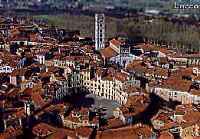

The most enjoyable way to get your bearings is to follow the path around the top of the Walls - nearly 4km in extent and built with genuine defensive capability in the early sixteenth century, before being transformed to their present, garden aspect by the Bourbon ruler, Marie Louise. In the centre of town, just east of the main Piazza Napoleone on Piazza San Martino, the Duomo of San Martino (closed 3.30-6.30pm) was in part sculpted by Nicola Pisano, though sadly recent years have seen his sculptures covered for restoration, along with virtually all the high points of the great hall-like interior, which include paintings by Tintoretto, Ghirlandaio and Filippino Lippi. The most famous item, Jacopo della Quercia's Tomb of Ilaria del Carretto, has been restored so vigorously that one expert declared it had been ruined - prompting a libel action from the restorer. Lucca's finest sculptor was perhaps Matteo Civitali, whose Tempietto in the north aisle was sculpted to house the city's most famous and lucrative relic, the Volto Santo ("Holy Face") - said to be the "true effigy of Christ" and the focus for international pilgrimage.
Northwest of the Duomo across Via Fililungo, the facade of San Michele in Foro church is a triumph of eccentricity, each of its loggia columns different, some twisted, others sculpted or candy-striped. The interior is relatively plain, though there's a good Andrea della Robbia terracotta and a painting by Filippino Lippi. Giacomo Puccini was born almost opposite at Via di Poggio 30, and his home, the Casa di Puccini (April-Sept Tues-Sun 10am-1pm & 3-6pm; Oct-March Tues-Sun 11am-1pm & 3-5pm; L3000), is now a school of music with a small museum, featuring the Steinway piano on which he composed Turandot, along with original scores and photographs from premieres. At the end of the street in Via Galli Tassi is the seventeenth-century Palazzo Mansi, which houses a Pinacoteca Nazionale (Tues-Sat 9am-7pm, Sun 9am-2pm; L8000), an indifferent collection of pictures, although the Rococo palace itself is a sight, at its most extreme in a spectacularly gilded bridal suite.
Northeast of here, the basilica of San Frediano has a facade with a brilliant thirteenth-century mosaic of Christ in Majesty and fine treasures inside, most enjoyable of which is the font carved with Romanesque scenes of Moses, the Good Shepherd and Apostles; set behind it is a ceramic Annunciation by Andrea della Robbia.
Be sure to visit the remarkable Piazza Anfiteatro, a circuit of medieval buildings whose foundations are the arches of the Roman amphitheatre. Just southeast, the strangest sight in Lucca is perhaps the Casa Guinigi (March-Sept daily 9am-7.30pm; Oct 10am-6pm; Nov-Feb 10am-2.40pm; L4500), the fifteenth-century home of Lucca's leading family, with a battlemented tower surmounted by holm oaks whose roots have grown into the room below. Much of it is being restored, but from Via San Andrea you can climb it for one of the best views over the city. Across the narrow canal on Via della Quarquonia, the fifteenth-century Villa Guinigi is now the home of Lucca's major museum of art and sculpture, the Museo Nazionale Guingini (April-Sept Tues-Sun 9am-7pm; Oct-March 9am-2pm; L4000), with a good deal of lively Romanesque sculpture from the city and some good work by the cathedral's maestro, Matteo Civitali.
PracticalitiesThe train station is just outside the city walls to the south, an easy walk or short bus ride to the centre. The tourist office is on the north side of Piazza Verdi (daily summer 9am-7pm; winter 9am-2pm), a swish affair with plenty of information. Finding accommodation is a problem at almost any time of year. You could do well to email Luisa at lucca@antibes.co.uk to check out the availablility of some wonderful apartments in the town, but of the hotels, the Melecchi (0583/950.234; $16-24) and Stipino (0583/495.077; $32-40), at Via Romana 37 and 109, and Diana at Via del Molinetto 11 (0583/492.202; $24-32), are all good. After these the best bet is the Moderno, in the centre at Via Civitali 38 (0583/558.429; $32-40). There's a youth hostel with campsite at Via del Brennero 673 (0583/341.811; under $8), 3km north of the centre. For food, try the Trattoria da Guido, Via C. Battisti 28, the cheapest place in town, or Trattoria da Leo, Via Tegrimi 1. Trattoria da Giulio,Via del Tommaso 29, by the Palazzo Mansi, is also good and very popular, as is Ristorante all'Olivo, Piazza S. Quinico 1. For excellent pizza, with good beer, try the Gli Orti di Via Elisa, Via Elisa 17, or Salette, Piazza S. Maria 15, a big friendly place with tables outside.